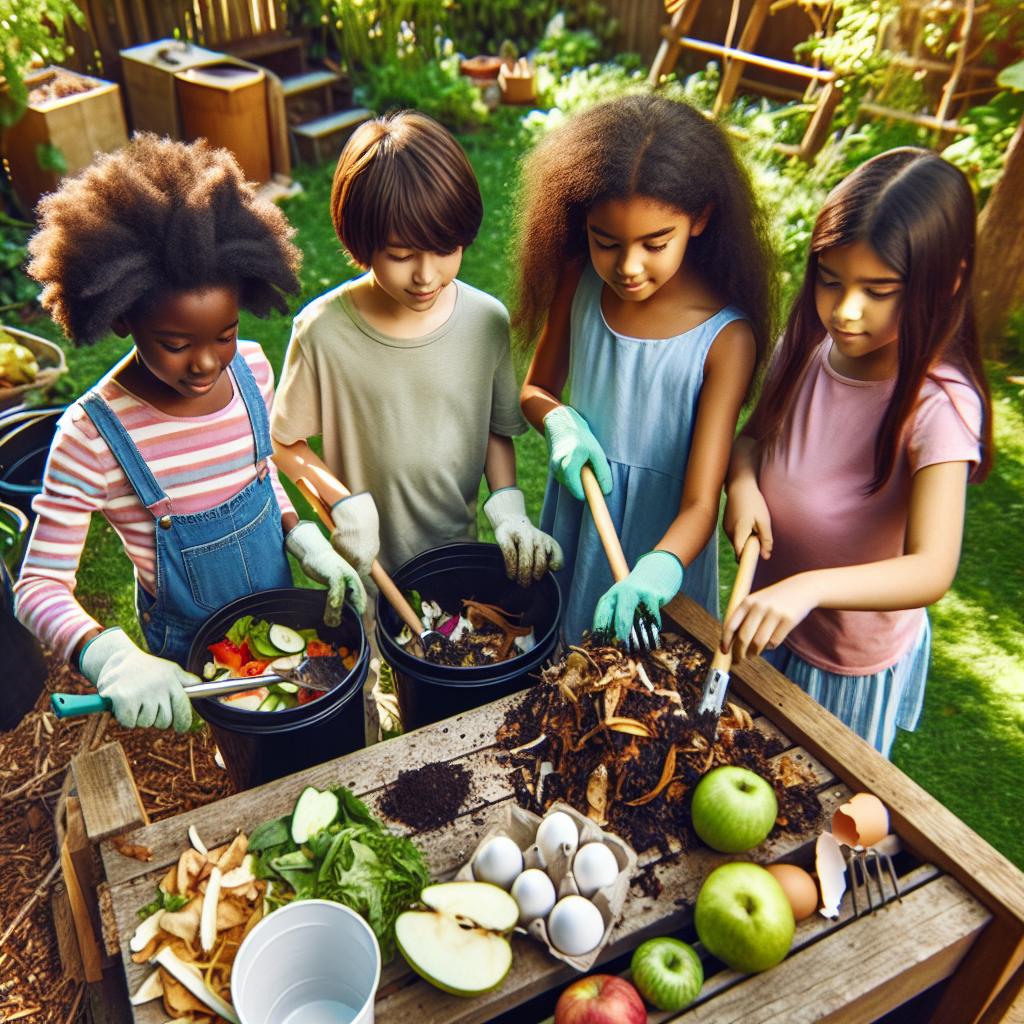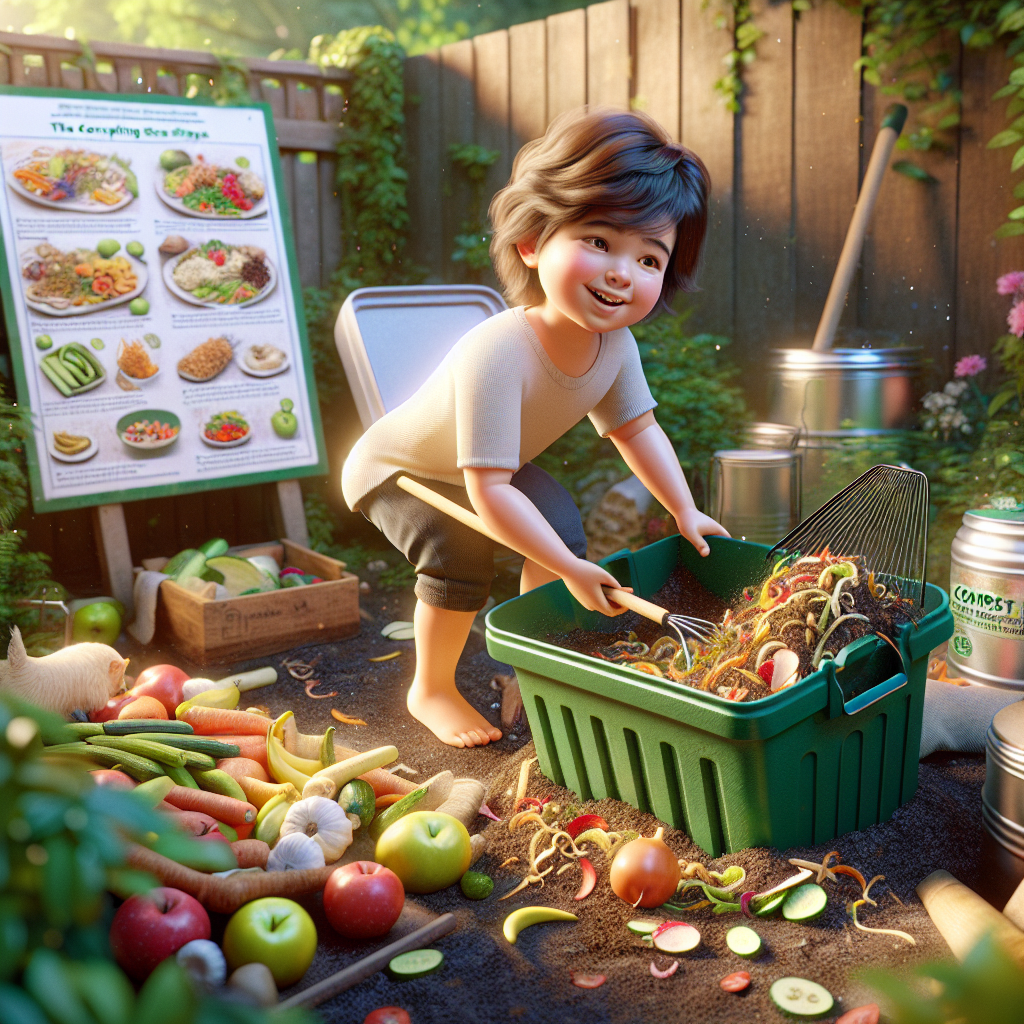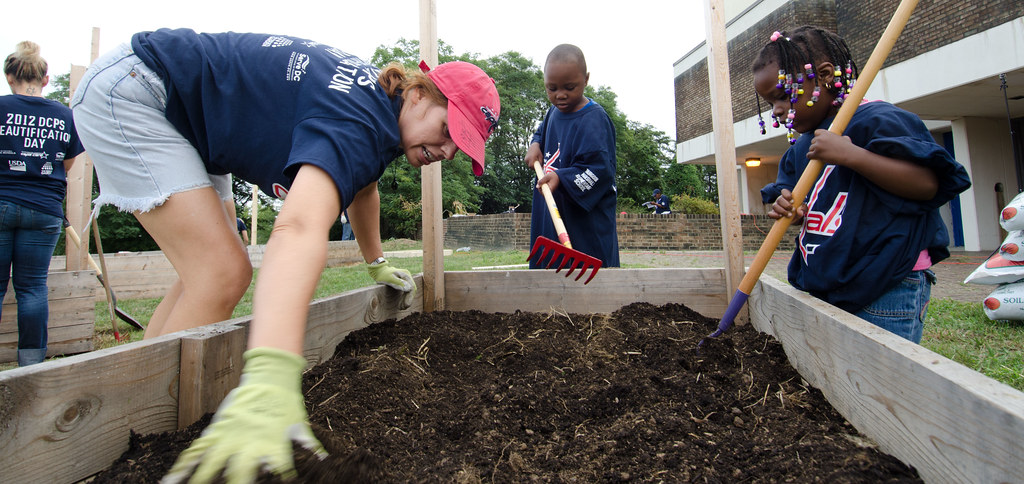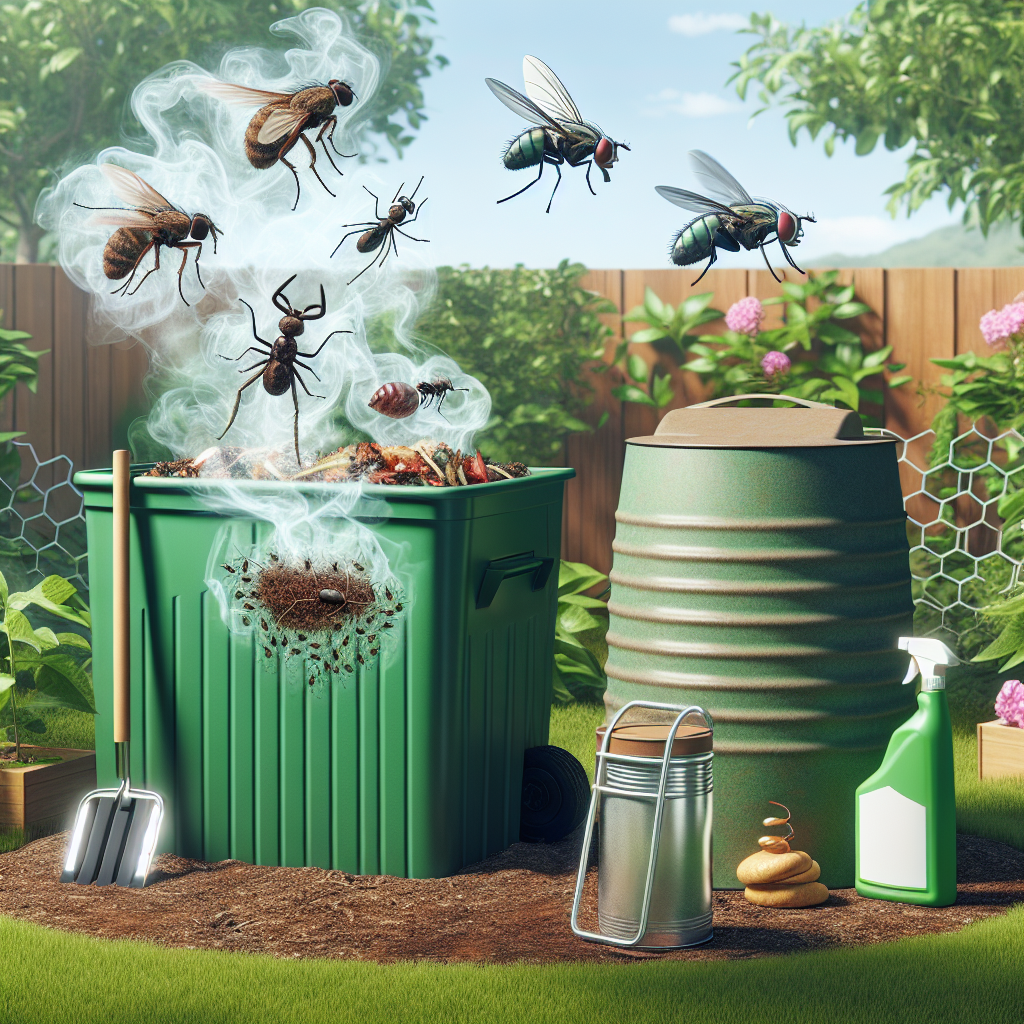Contents
- 1 Creating Your Family’s Compost Corner
- 2 Composting with Kids: Making It Fun and Educational
- 3 Maintaining Your Compost Pile
- 4 Understanding the Composting Process Together
- 5 Using the Compost: When Is It Ready to Use?
- 6 Compost Problems: Common Issues and Fixes
- 7 A Sustainable Cycle: Using Compost to Grow More Greens
- 8 Frequently Asked Questions
- 9 Author

Key Takeaways:
-
Composting is an eco-friendly way to recycle organic waste into nutrient-rich soil for your garden.
-
Setting up a compost bin can be a family activity, providing education and hands-on experience for kids.
-
Understanding the balance of ‘browns’ and ‘greens’ is crucial for successful composting.
-
Regular maintenance, such as turning and watering, accelerates the composting process.
-
Finished compost is a sign of a successful cycle and can be used to enrich your garden’s soil.
The Magic of Compost: Transforming Waste into Garden Gold
Imagine turning your kitchen scraps and yard waste into a treasure trove for your garden. That’s what composting does—it’s like alchemy for eco-conscious gardeners. Compost enriches the soil, helps retain moisture, and suppresses plant diseases. It’s a cornerstone of sustainable gardening and, most importantly, it’s something the whole family can get involved in, especially the kids.
What Compost Is and Why It Rocks
At its core, compost is decomposed organic matter. It’s what happens when leaves fall in the forest and gradually turn into a layer of rich, dark, crumbly soil. Compost is teeming with life, from microscopic bacteria to worms and fungi, all breaking down organic materials into basic nutrients that plants can absorb. It’s a perfect example of nature’s recycling system.
Why should we compost? For starters, it reduces the amount of waste sent to landfills, where it would release methane, a potent greenhouse gas. But for gardeners, the benefits are even more immediate. Compost improves soil structure, provides a balanced source of nutrients, and fosters healthy plant growth. And there’s something deeply satisfying about creating this “black gold” from what would otherwise be trash.
Example: One family started composting their vegetable peels, coffee grounds, and eggshells. In less than a year, they transformed their sandy, lifeless backyard soil into a thriving vegetable garden, all thanks to the power of compost.
The Immediate Positive Impact on Your Garden
Adding compost to your garden can work wonders. It’s like giving a vitamin boost to your plants. The slow release of nutrients ensures that plants get what they need over time, rather than the quick hit from synthetic fertilizers. This leads to stronger, more resilient plants. And because compost improves soil structure, it helps the soil hold onto water during dry spells, making your garden more drought-tolerant.
Creating Your Family’s Compost Corner
Getting started with composting doesn’t require a lot of space or special equipment. A small corner of your yard or balcony can serve as your compost headquarters. The key is to choose a spot that’s convenient for adding materials and, if possible, close to your garden where the finished compost will be used.
Choosing Your Compost Bin Location and Style
When it comes to selecting a compost bin, there are several styles to consider. Some are simple, like a pile or an open bin made of recycled pallets. Others are more complex, like tumblers that make turning the compost easier. The size of your family, the amount of waste you generate, and your gardening goals will guide your choice. Here’s a quick comparison:
|
Compost Bin Type |
Pros |
Cons |
|---|---|---|
|
Open Pile |
Easy to start, no cost |
Less tidy, may attract pests |
|
Enclosed Bin |
Pest-resistant, neater appearance |
May have limited capacity |
|
Tumbler |
Easy to turn, faster decomposition |
More expensive, requires more space |
Once you’ve chosen your bin, place it on well-drained soil or grass. A partially shaded spot is ideal as it prevents the compost from drying out too quickly in the sun or becoming too soggy in the rain.
Gathering the ‘Ingredients’ for Your Compost
Composting is like cooking for the soil, and just like any good recipe, it requires a balance of ingredients. There are two main types of materials you’ll need: ‘browns’ and ‘greens’. Browns are carbon-rich materials like dried leaves, straw, and shredded paper, while greens are nitrogen-rich materials like kitchen scraps and grass clippings. A good mix of both is essential for healthy compost.
-
Browns (Carbon): Leaves, twigs, cardboard, paper
-
Greens (Nitrogen): Vegetable scraps, fruit peels, coffee grounds
Start by layering browns and greens in your bin, aiming for a ratio of about 3:1, brown to green. This mix will provide the right balance of carbon and nitrogen to feed the microorganisms that do the decomposing work.
Composting with Kids: Making It Fun and Educational

Getting kids involved in composting is a fantastic way to teach them about the environment, responsibility, and science. By turning waste into something valuable, they can see firsthand the benefits of recycling and caring for the earth.
Assigning Age-Appropriate Composting Roles
Children of all ages can participate in composting. Even toddlers can help by collecting suitable kitchen scraps in a small pail. Older children can be responsible for layering materials in the compost bin and turning the pile. Here’s how to assign tasks based on age:
-
Toddlers: Collecting scraps and sprinkling water
-
Elementary-aged children: Layering browns and greens, turning the pile with supervision
-
Teens: Managing the compost pile, troubleshooting any issues
Remember, the goal is to make composting a fun and rewarding activity for the whole family. Celebrate every step, from the first deposit of kitchen scraps to the harvesting of the finished compost. Encourage curiosity and questions—it’s all part of the learning process.
Maintaining Your Compost Pile
Once your family’s compost corner is up and running, the key to rich, fertile compost is in the maintenance. It’s not just about tossing scraps into a bin; it’s about nurturing the pile so that it breaks down effectively. This is where you teach the kids that a little effort goes a long way in helping our environment.
Keeping the Balance: Browns vs. Greens
One of the most important lessons in composting is learning the balance between ‘browns’ and ‘greens’. Browns are your carbon-rich materials, such as dried leaves and cardboard. Greens, on the other hand, are your nitrogen-rich materials like fruit and vegetable scraps. A healthy compost pile should have a ratio of about 3 parts browns to 1 part greens. This balance helps to speed up the decomposition process and prevents the pile from becoming too wet and smelly.
Turning and Watering: The Secrets to Speedy Composting
Another secret to a successful compost pile is turning it regularly. This aerates the pile, providing oxygen to the microorganisms at work. A simple garden fork or compost turner can be used to mix the materials. Aim to turn your compost about once a week. Water is also essential, as it helps to break down the materials. Your compost should be as moist as a wrung-out sponge. If it’s too dry, add water; if it’s too wet, add more browns.
Here’s a simple guide to help you and the kids keep your compost healthy:
-
Turn the compost once a week to introduce oxygen and speed up the process.
-
Check the moisture level whenever you turn the pile and adjust as needed.
-
If your compost smells, add more browns to absorb excess moisture and reduce odor.
-
Chop or shred larger pieces to help them decompose faster.
-
Keep a balance of materials to avoid attracting pests.
By maintaining the compost pile together, you’re showing your children the value of regular care and attention, not just in gardening, but in all aspects of life.
Understanding the Composting Process Together

“20120825-DM-LSC-0129 | Ellen Anderson …” from www.flickr.com
Composting is a fantastic way to bond with your kids and teach them about the natural cycles of life. As you add to and turn your compost pile, take the opportunity to talk about what’s happening on a biological level. Explain that the greens provide nitrogen, which is like food for the microorganisms, while the browns provide carbon, which is their bedding.
These tiny creatures are the real heroes of composting. They’re breaking down the materials into simpler substances, which will eventually nourish your garden. It’s a process that’s both fascinating and fundamental to understanding how nature recycles and sustains itself.
From Scraps to Soil: The Science Behind Decay
Composting is a clear demonstration of the scientific principle of decay. When organic matter breaks down, it’s thanks to a combination of physical and biological processes. Microorganisms, such as bacteria and fungi, consume the organic materials, breaking them down into their constituent parts. This decay process is natural and necessary—it’s how nutrients are returned to the soil, completing the life cycle of plants.
Watching Nature at Work: The Decomposition Timeline
Decomposition doesn’t happen overnight. It’s a timeline that can vary depending on what you’ve added to your compost pile and the conditions you maintain. Here’s a rough breakdown of what to expect:
Example: Fresh greens, like vegetable scraps, will start to break down within days. Browns, like leaves, may take several weeks to several months. With regular turning and the right conditions, most compost piles are ready to use within 3 to 6 months.
Patience is key, and this is a great opportunity to teach kids about delayed gratification. The reward of rich, homemade compost is worth the wait.
Using the Compost: When Is It Ready to Use?
The moment you’ve all been waiting for—using your homemade compost in the garden! But how do you know when it’s ready? Mature compost will be dark, crumbly, and smell like earth. It should be free of any large, recognizable pieces of the original materials.
Spotting Mature Compost: What to Look For
Mature compost is a joy to behold. It’s a sign that your hard work and patience have paid off. The compost is ready to use when it’s dark brown and has a soil-like texture. You shouldn’t be able to identify any of the original ‘ingredients’. If you see a lot of unfinished material, it’s a good idea to let it decompose a bit longer.
Time to Use: Integrating Compost into Your Garden
Once your compost is ready, it’s time to put it to good use. Spread it on your garden beds to enrich the soil, mix it into potting soil for your houseplants, or use it as a top dressing for your lawn. The nutrients in the compost will help your plants grow strong and healthy.
Here are some ways to use your finished compost:
-
Mix it into garden beds before planting.
-
Use it as mulch around established plants.
-
Add it to potting mixes for container gardening.
-
Spread it thinly over your lawn as a natural fertilizer.
By using compost in your garden, you’re closing the loop on the recycling process and contributing to a more sustainable world.
Compost Problems: Common Issues and Fixes

Even with the best intentions, sometimes compost piles can run into problems. But don’t worry, most issues are easily fixable. It’s all part of the learning process and a chance to show kids how to problem-solve.
Here are some common compost problems and their solutions:
-
If your compost is too wet and smelly, add more browns to soak up excess moisture.
-
If it’s too dry and not decomposing, add more greens and a bit of water to moisten it.
-
Stir the pile more frequently to aerate it if you notice it’s not breaking down.
-
If you see pests, make sure you’re not adding any meat, dairy, or oily foods, and keep the pile covered.
Odor Control: Keeping Your Compost Smell-Free
A well-maintained compost pile should have a pleasant, earthy smell. If it starts to stink, that’s a sign that something’s off balance. Usually, it means there’s too much moisture and not enough air. To fix this, turn the pile to introduce more oxygen and add dry ‘browns’ like leaves or shredded newspaper to absorb the excess moisture.
Remember, composting is an ongoing learning experience. By troubleshooting these issues together, you’re not only keeping your compost healthy, but you’re also teaching valuable lessons in environmental stewardship and science.
Pest Proofing: Safeguarding Your Bin from Unwanted Guests
One potential hiccup in the composting journey is the arrival of unwanted guests. Critters are naturally attracted to the smorgasbord in your compost bin, but there are steps you can take to keep them at bay. First, ensure that your compost bin has a secure lid or cover. This not only deters animals but also helps regulate moisture levels. Second, avoid adding meat, dairy, or oily foods to your compost, as these can attract pests and cause odor issues. Lastly, keep your compost well-balanced and turn it regularly, as a hot and active compost pile is less appealing to pests.
A Sustainable Cycle: Using Compost to Grow More Greens
Using the compost you’ve created is the most rewarding part of the process. It’s a sustainable cycle that keeps on giving. By enriching your garden soil with compost, you grow healthier plants, which in turn provide more organic matter for your next batch of compost. This cycle not only benefits your garden but also contributes to a healthier planet by reducing waste and the need for chemical fertilizers. The satisfaction of watching your garden flourish thanks to your family’s composting efforts is priceless.
Success Stories: Plants That Thrive on Compost
Many plants thrive with the addition of compost, but some are absolute champions when it comes to benefiting from this organic gold. Vegetables like tomatoes, peppers, and zucchinis respond well to the nutrient-rich boost, often resulting in a more bountiful harvest. Flowers such as marigolds, sunflowers, and cosmos also flourish, displaying vivid colors and strong stems. By using compost, you’re not just growing plants; you’re nurturing a vibrant ecosystem in your backyard.
Replenishing the Cycle: Saving Scraps for Future Composting
To keep the composting cycle going, it’s important to continuously save scraps and add them to your compost bin. Encourage your family to make it a habit to collect appropriate kitchen waste like fruit peels, vegetable scraps, and coffee grounds. You can keep a small compost caddy in the kitchen to make this process easier. By continually contributing to your compost pile, you ensure an ongoing supply of rich compost to feed your garden year after year.
Frequently Asked Questions

Can I compost if I live in an apartment?
Absolutely! Composting isn’t just for those with big backyards. Apartment dwellers can use small, indoor compost bins or worm composting systems. These are designed to fit in tighter spaces and can be kept odor-free with proper care. Some cities also offer community composting programs where you can bring your organic waste to be composted off-site.
How long does it take for compost to be garden-ready?
The time it takes for compost to become garden-ready can vary, but generally, it ranges from three to six months. Factors such as the balance of materials, the size of the compost pieces, and how often the compost is turned can all affect the timeline. A well-maintained compost pile that’s regularly turned and has the right mix of browns and greens can decompose faster than one that’s neglected.
What items should never go into the compost bin?
While many organic materials can be composted, there are some that should never be added to your compost bin. These include:
-
Meat and fish scraps
-
Dairy products
-
Fats and oils
-
Pet waste
-
Diseased plant materials
Adding these items can create odor problems, attract pests, and potentially spread disease in your garden.
Do compost bins attract animals or insects?
Compost bins can attract animals and insects if not properly maintained. However, by following best practices like keeping the pile balanced, turning it regularly, and not adding materials that are likely to attract pests, you can minimize this risk. A well-constructed bin with a lid or cover can also help keep animals out.
How can I tell if my compost is too dry or too wet?
The ideal compost should have the moisture content of a wrung-out sponge. If it’s too dry, the materials won’t break down effectively, and you’ll need to add water. If it’s too wet, it may become anaerobic and smelly, and you’ll need to add more ‘browns’ to absorb the excess moisture. Regularly checking the moisture and adjusting as needed is a key part of compost maintenance.



